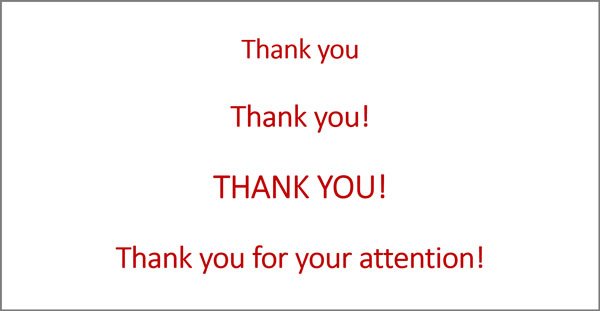Visuals
Rethinking Final Slides

All good things must come to an end, but how? As your presentation draws to a close, how should you wrap it all up so that you end with a bang, and not a fizzle? In John’s earlier post, Rethinking Title Slides, he considered the options available when opening your presentation. Now he turns his attention to the ending.
In a previous post, I offered a few ways to think differently about the title slide in your PowerPoint presentations. Contrary to what many people think, a title slide is not always necessary. And, if you have one, there is no rule that says that it has to be the first slide that you show.
Well, if we have looked at the title slide, it only seems right that we look at final slides as well.
Thanks but No Thanks!
Perhaps the most common final slide that you see is the one that thanks the audience. Here are some of the standard variations:
You get the idea. And they are all bad options.
Many clients are genuinely surprised when I tell them never to use a “Thank you” slide again. But there are two solid reasons for not doing so.
First, in many cases, you should not thank your audience. Imagine Martin Luther King as he brought his inimitable I Have a Dream speech to close. Imagine if he had added a “Thank you” to the ending:
“And when this happens, when we allow freedom to ring, when we let it ring from every village and every hamlet, from every state and every city, we will be able to speed up that day when all of God’s children, black men and white men, Jews and Gentiles, Protestants and Catholics, will be able to join hands and sing in the words of the old Negro spiritual, “Free at last! Free at last! Thank God Almighty, we are free at last! Thank you very much!”
Something powerful, something fundamental would have been lost. “Thank God Almighty” that King was smarter than that. He knew that leaving the audience with rousing oratory to inspire them was the only way to end that speech.
In situations where you are presenting your vision to the company, or exhorting your audience to take some kind of action, dispensing with “Thank you” is the best option. Instead, leave them with something that sticks long after they have left the auditorium. Some hypothetical examples are below:
And I know, that if we work together, we will succeed!
You know what you have to do. Now, go out there and do it!
The journey will be long and the journey will be hard, but there is no turning back. I am confident we will reach our destination.
Second, if you would like to thank your audience and it is appropriate to do so, is having a slide that says “Thank you”, which you typed out two days (or two hours) before really the best way? Of course not!
If you want to thank your audience, look them in the eye and thank them from the heart, not the screen. They will appreciate the connection and your thanks will be much more authentic and therefore much more meaningful.
Without Question
Another bad slide on which to end is the following:
Does your audience need a slide to know that you are moving to a Q&A session? Of course not. If you want to have a Q&A session, have a black slide and then open the floor up for questions.
As an aside, I believe that, when speakers have control over the situation, they should not end with a Q&A. Why not? Because you never know whether the questions are going to be on point or interest only to a few people. There is a risk that many people in the audience will reach for their smartphones and that is how your presentation will end: with a fizzle, not a bang.
So I always recommend that speakers cover everything they want to cover and then announce that they will take questions for however many minutes they like before they conclude. That way, the speaker controls the conclusion.
6 Good Closing Slides
So, if slides like “Thank you” and “Questions?” and, worst of all, “Thank you! Questions?” are out, what should you have for a final slide?
There is no hard and fast rule, and the final slide that you choose will depend on things like the audience and your message. But here are some good options:
1) A powerful image
Use an image that relates to your talk and that captures the feeling or message that you are trying to convey.
2) A summary of your key points
You can use a subtle animation such as “Fade” (PowerPoint) or “Dissolve” (Keynote) to bring your points in one by one, emphasizing each as you go.
3) A call to action
Inspire your audience and move them to action.
For example, let’s imagine that a company has been having trouble invoicing its customers on time. The problem has been traced to a lack of communication between the sales team and the accounting department. A final slide for such a presentation could list what is expected from Sales, what is expected from Accounting and what is expected from both.
4) A quote
Use a quote that relates to your message, perhaps with an image of the person who first said it. This slide could be doubly powerful if you opened the presentation with the quote (not using a slide) and then returned to it at the end of the presentation to reinforce the idea.
5) Your contact details
This is especially useful when speaking to large audiences whom you do not know. But keep the information simple and easy to write down. An email, a phone number and a website address are good options, individually or in combination.
6) A black slide
Yes, a black slide can be a good option, for example if you want to end your presentation with a powerful story. By turning the screen black, you refocus the audience’s attention on you. Never forget that the slides are not the presentation; the speaker is the presentation and the slides are there to support the speaker.
As I mentioned in my previous post, psychologists frequently talk about the learning principles of primacy and recency. People tend to remember the first thing they hear or see and the last thing they hear or see.
So don’t waste your final slide on something as banal as “Thank you” or “Questions?”. You can do much better than that. Your presentation will have a polished ending and your audience will appreciate it.
If you have any thoughts on this subject or think I’ve missed any good final slide ideas, please feel free to share them with us in the Comment section below.


rohit aggarwal
15th April 2019 at 8:42 am
thanks for the information
John Zimmer
23rd April 2019 at 10:42 am
Thank you, Rohit. Glad you found it helpful.
Canopas
10th November 2023 at 8:54 am
Such an insightful read! The final slide often lingers the longest in our audience’s memory—it’s where we leave a lasting impression. Rethinking this crucial part of the presentation might just be the key to leaving a more impactful message.